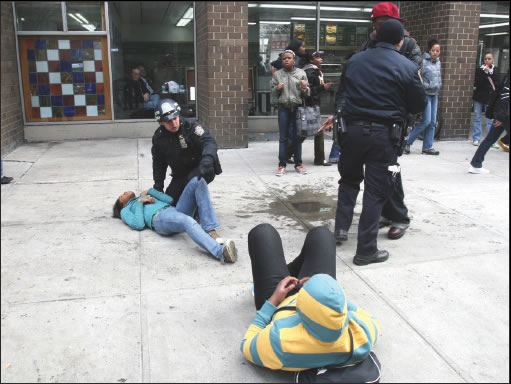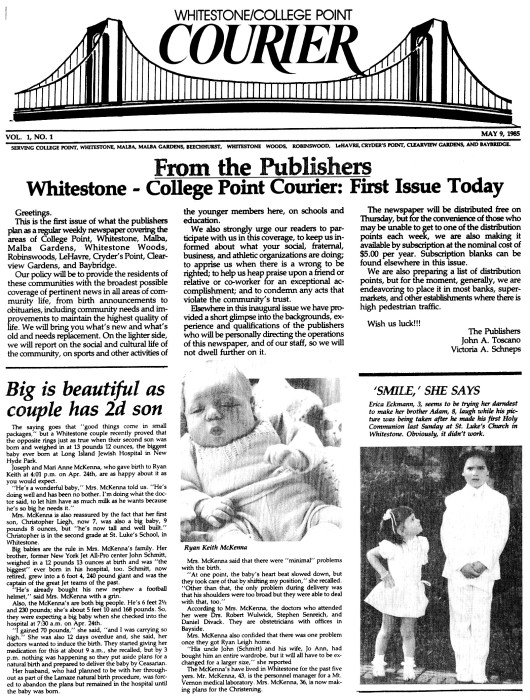By Julie Shapiro
As the school bell rang at Murry Bergtraum High School Wednesday, a throng of students poured out onto the sidewalks, heading for the Fulton St. Burger King.
At the corner of Fulton and Gold Sts., the crowd stopped, circled, multiplied. Two girls in the center shouted and threw punches. More than 100 students egged them on.
Within 45 seconds, eight police officers stationed at the Burger King plowed into the crowd. By the time they got to the center, the fight was over and one girl lay on the ground, struggling to get up. The police radioed for backup and cleared out the area, but they made no arrests.
This was the latest episode in a string of violent encounters near the Burger King, which usually involve Murry Bergtraum students, First Precinct Deputy Inspector Anthony Bologna said.
But violence wasn’t always the first thing neighbors thought of when they heard the name “Murry Bergtraum.”
With an innovative business education program, the school was the first in the city to teach computer science and among the first in the country to require students to do business internships. The highly selective school had a reputation for strong teachers, relevant coursework and student achievement.
Now, 33 years after Murry Bergtraum opened, the school attracts more complaints than accolades. Many Southbridge Towers residents say the students are unruly and disruptive. Students say classes and hallways are crowded, while some teachers say they are overwhelmed by an influx of unengaged students.
A former principal and two faculty leaders say the school has becoming a dumping ground for students who don’t get into other schools.
It’s hard to imagine how such a large shift happened so quickly, especially for Barbara Christen, Murry Bergtraum’s founding principal. She has followed the school closely since she left in 1989.
“They’ve killed it, from what I hear,” Christen said in a phone interview from her Connecticut home.
The culprit is the city’s decision to close large schools and replace them with several smaller ones, Christen and several school employees said. The smaller schools are often elite, siphoning off the top performers and dumping the rest in already-overcrowded schools like Murry Bergtraum, they said.
“Kids are literally being stuffed into whatever schools are available,” Christen said. “That’s the surest way to take a successful school and make it unsuccessful.”
John Elfrank-Dana, the school’s United Federation of Teachers chapter leader, has seen the same problems.
“The academic ability and social need of the students has really changed in the last five years, especially the last three years,” said Elfrank-Dana, who has been teaching social studies at Murry Bergtraum since 1986. “These kids are really needy. A lot of these kids raised themselves.”
He and David Gordon, chairperson of the School Leadership Team, wrote a letter to the editor decrying what they see as Schools Chancellor Joel Klein’s “jihad against large schools.” [See letters, page 16]
Barbara Esmilla, current principal of the school, said the changes reflect the student population in all of New York City, not just at Murry Bergtraum.
“If I said I wasn’t serving a different population [than 30 years ago], I would be living with my head in a bubble,” said Esmilla, who also taught in the school from 1976 to 1997. “But it’s across the board — students come to school with a different skill set and different moral values.”
In the past 30 years, New York has seen an explosion of new schools, many of which have a specialized focus. That means more competition for the best students, which can hurt large schools like Murry Bergtraum, Esmilla said.
Still, Bergtraum has grown since it held 2,400 students in the 1970s. The school’s population ballooned up to 3,300 in the late ’90s but has now settled closer to 2,700.
“A lot of these kids don’t even want to be here, and that’s a first in this school’s history,” Elfrank-Dana said.
When Klein closed Seward Park High School in 2006, many of the displaced students ended up at Murry Bergtraum, Christen said.
“These were kids who didn’t know anything about the school, they had no conviction that what they wanted to study was business, and many were in the lower areas of academic achievement,” Christen said. “For a school to be successful, it is essential that students see value in what they’re being asked to do. If they don’t see value in it, it’s uninteresting, it’s boring, and they may very well be failing.”
Margie Feinberg, a Department of Education spokesperson, said the city did not track the Seward Park students’ transfer decisions. She said students who listed Bergtraum as one of 12 choices could have been transferred there. “No kids are dumped anywhere,” she said.
Christen sees no reason for Klein’s decision to close large schools. Their size means they can offer a broader array of classes and teachers, she said.
“Big schools are almost like universities,” said Gordon, an English teacher at Murry Bergtraum since 1992. “Because of their size, they are able to offer different programs.”
Elfrank-Dana agreed that there are advantages to large schools, but only if class sizes are reduced. Classes at Murry Bergtraum have an average of 28 students and can have up to 34, whereas Elfrank-Dana said 20 is the ideal size.
Klein did not respond to an e-mail requesting comment.
Bergtraum’s beginnings
Christen painted a picture of Murry Bergtraum’s early years, when the attendance rate regularly topped 93 percent and 30,000 students applied for 800 spaces in the freshman class. The school was the first in the city to teach computer programming in the 1980s on an enormous IBM keypunch machine.
Students interned — and got paid — at the New York Stock Exchange and a host of companies with Downtown headquarters. Major banks came to the school each February to recruit graduating seniors, 85 percent of whom went on to college even while the citywide average was in the 60s. After taking advanced classes at Murry Bergtraum, some students finished college in only three years.
The students “were eager to come to school,” Christen said. “They felt they were moving into something that was connected to the rest of their life. They had a direction and a goal.”
From 1975 to the mid-’80s, Murry Bergtraum’s guidance department selected the entire incoming class according to strict guidelines determined by the city. Twenty-five percent of the students were high achievers, 50 percent were average and 25 percent were below grade level. Students came from all five boroughs, and roughly 45 percent were black, 35 percent were Hispanic and the rest were split between white and Asian. The demographics are similar today, but with the Hispanic and black populations flipped.
“We had some of every problem that beset the school system, but not an overwhelming amount of any one problem,” Christen said.
That changed in the mid-1980s, when the Department of Education started using a computer to randomly select the students who would attend Bergtraum, she said. The new system still abided by the old 25-50-25 guidelines, but now the school had less say over an individual student’s admission. The lack of choice hurt the school in terms of the 25 percent of students below grade level, when it was most important to evaluate each student’s application as an individual case, Christen said.
Christen recalls a student in a secretarial transcription class who could not read. Students in need of that much remedial help could not benefit from the school’s trademark business program. And in order to help those students, Christen had to consider eliminating the specialized business courses that earned Murry Bergtraum its recognition. Still, the D.O.E. kept feeding the school more of these high-need students than the school could successfully absorb, Christen said.
“All kids bring something to the school,” she said. “But if everyone comes in bearing the same enormous burdens, that’s when you’ve got a problem. The burdens become the [focus].”
Today, the school picks half of the incoming class while the D.O.E. picks the other half, Feinberg said. The D.O.E. also places new students or students transferring from private schools.
During Christen’s tenure, misbehaving students feared Christen would deliver the ultimate punishment: force them to transfer. Now, because of a lawsuit in the 1990s, principals can’t transfer students without the consent of their parents, Esmilla said.
Esmilla’s description of Bergraum’s early years matched Christen’s.
Breaking the school up?
Starting in September 2006, the school broke up into “small learning communities,” which keep students together for core classes, to “offer a more personalized approach,” Esmilla said.
But class sizes stayed the same and Elfrank-Dana said teachers are just as overworked under the new system, if not more so.
He also sees the small learning communities as an ominous sign for the future. At other large city schools, breaking students into groups like these communities was the first step toward closing the school, he said. Elfrank-Dana added that he has not heard anything concrete about Klein planning to close Bergtraum.
“This school is very far from closing,” Esmilla countered, saying that only the city’s best large schools were selected to pilot the small learning communities program. “We are doing very well,” she said. Feinberg, of the D.O.E., also confirmed that there are no plans to close the school. On the recent report card rankings, which heavily weight student improvement, Murry Bergtraum received a C.
Esmilla started working at the school as a student teacher in 1976 under Christen and then became a teacher the next year. Esmilla stayed at the school for 21 years, then left to work as an assistant principal at several other schools before returning to Murry Bergtraum as principal six years ago. She cited Murry Bergtraum’s recent accomplishments, which include students getting into Ivy League schools, mentoring programs with Lehman Brothers and Estee Lauder, a Big Brothers/Big Sisters program and a recent visit by singer Fergie.
Lorraine Fittipaldi, an aide at the school who lives at Southbridge Towers, also drew attention to Murry Bergtraum’s positive features, saying she’s tired of hearing the school denounced.
“I wish everyone would just take a look at the whole picture,” she said. “There is a lot a lot of good that comes from that school.”
Fittipaldi described students who win full college scholarships, students who join clubs and the National Honor Society, and students who paint murals and organize events.
“You’re going to have bad kids wherever you go, but it’s taken care of,” she said. The students might talk back to her sometimes, but most of them want to behave and do well, she said.
The Burger King Scene
Residents of Southbridge Towers complain regularly of disruptive teenagers hanging out in front of the Fulton St. Burger King after school. The students, a handful of whom come from several other local schools in addition to Murry Bergtraum, are noisy, unruly and occasionally violent, neighbors say.
Community Board 1 wants to meet with Esmilla to discuss solutions to the students’ behavior, but Esmilla declined invitations. She is wary about meeting with the community board after a contentious meeting in her office last spring. Esmilla invited one Southbridge Towers resident, but 10 people showed up uninvited. “I got attacked,” Esmilla said.
“She was talking to them, but everyone was bombarding her,” said Fittipaldi, who also attended the meeting. “It’s hard to hold a meeting when you have everyone screaming.”
Paul Goldstien, an aide to Assembly Speaker Sheldon Silver and a Southbridge resident, told C.B. 1 last week that he’s speaking with the D.O.E. about arranging a meeting. Esmilla said she would discuss any potential meeting with the D.O.E.
Christen called Esmilla “one of the most, if not the most, beloved principals I’ve ever known. Kids just adore her — she’s so outgoing, so genuinely concerned.”
But, Christen said, there are limits to what Esmilla can do.
“The principal does not have any control over students once they leave the school building,” Christen said. “It has to be done by the police…working as close as they possibly can with her.”
On a recent afternoon, several days before Wednesday’s fight, students poured out of Murry Bergtraum, chatting on their cell phones and plugged into iPods. Couples held hands or argued and groups of boys swung their backpacks and tossed snowballs.
Many students headed for the Burger King, where four police officers and two Southbridge Towers security guards waited. Apparently dissuaded from loitering, the teenagers either ate inside or took their food with them, unwrapping burgers as they continued down Fulton St.
“If the police aren’t here, [the students] start fights, squabbles, they harass tenants,” said Duane, a security supervisor for Southbridge Towers who did not want to give his last name. “It’s mostly Murry Bergtraum. They try to say it’s not, but it’s mostly them.”
“The students that the neighborhood sees on Fulton and Gold represent a very small portion of students,” Esmilla said. She said the students are from other local schools as well. Even Feinberg, a spokesperson for the entire school system, suggested the Fulton problem could be blamed on several schools, including Bergtraum.
Anibal Monegro, an 11th-grader from Brooklyn, was waiting for his friends outside of Murry Bergtraum. He likes to walk around the Seaport area after school.
“They tell us to go straight home, but I should be allowed to eat where I want to,” Monegro said. He prefers Wendy’s over Burger King, not just because of the police posted in front of Burger King, but also because the food at Wendy’s is better, he said.
Wunmi Aregbesola walked out of Burger King with a friend, carrying a bag of food. The 11th grader from Brooklyn called Burger King her “hangout spot,” and said problems only happen when it’s warmer outside. Even then, she said students fight with their fists, not guns, and no one gets seriously hurt.
Although she thinks Murry Bergtraum is overcrowded and some of the teachers “just don’t care,” Aregbesola likes the school. It’s the fourth high school she has attended and she means to stay, then go on to college and study public relations. “It’s a good school,” she said.
Christen, who founded the Futures and Options internship program through the Downtown Alliance, retired in April and is looking to get involved again in Murry Bergtraum. “I’m sad,” Christen said of the changes at the school. She hopes to create a committee of school personnel and community members to brainstorm ways to get Murry Bergtraum back on track.
With reporting by Jefferson Siegel














